The post Feature spotlight: copying a plan appeared first on Beyond.
]]>On Beyond, you can create a plan for your new financial year in two clicks, by basing it on your current plan.
First, click into your current plan and select ‘copy this plan’ from the menu.
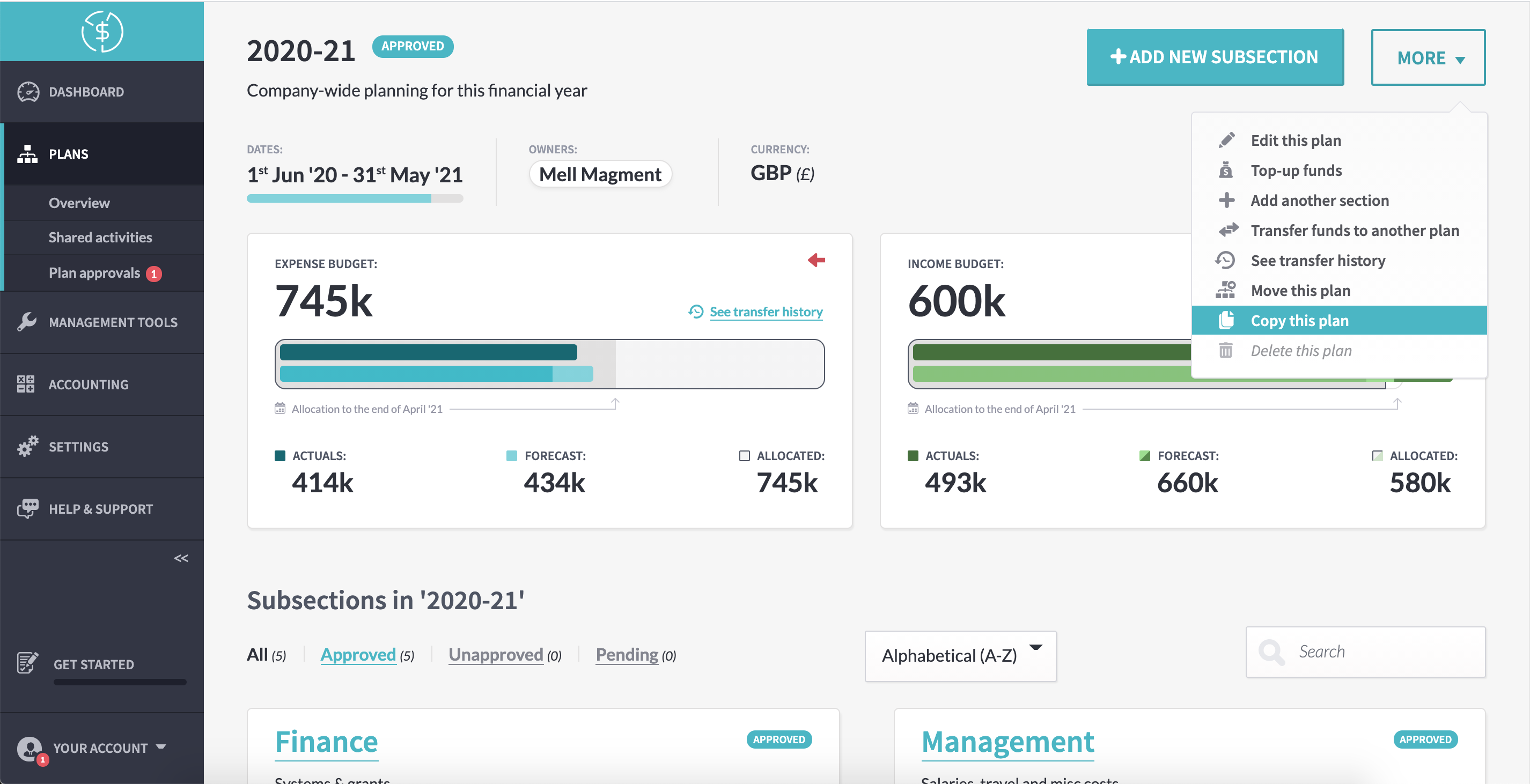
This will bring up a form where you can pick a plan name, an end date, and choose whether the plan budget is already approved.
If you want everyone who’s contributing to the plan to submit their budgets to you for approval, leave this on ‘no’. This is useful if you plan with bottom-up budgeting – if you don’t have exact numbers planned out for each department and you want them to put together a plan of what they’ll need for you to sign off on. (Just remember, your plan will only be reachable from the ‘unapproved’ tab until you’ve approved everyone’s budget!)
If you’re giving everyone a set amount and leaving them to sweat the details, tick ‘yes’. If you’re planning with top-down budgeting, this will save you some time!

And – that’s it! Once you hit the ‘copy this plan’ button, a new zero-based* plan will be created, modelled on the same structure.
The details – like budgets, forecasts, and – of course! – actuals won’t be carried across, but the structure of the plan will. Your new plan will be broken down into the same departments, teams, and budget owners. Though you’re free to edit and delete as you need, without affecting the original plan.
Best of all, the activities in the original plan will be extended into the new plan; this means ongoing expenses, like rent and utility bills, will already be accounted for. Any changes made to them inside the new plan won’t affect their numbers inside the original, but the two will be linked together; your team can quickly switch between financial years to compare and track numbers.
And any automatic rules you’ve set up on your activities will keep running – you don’t need to set them all up again!
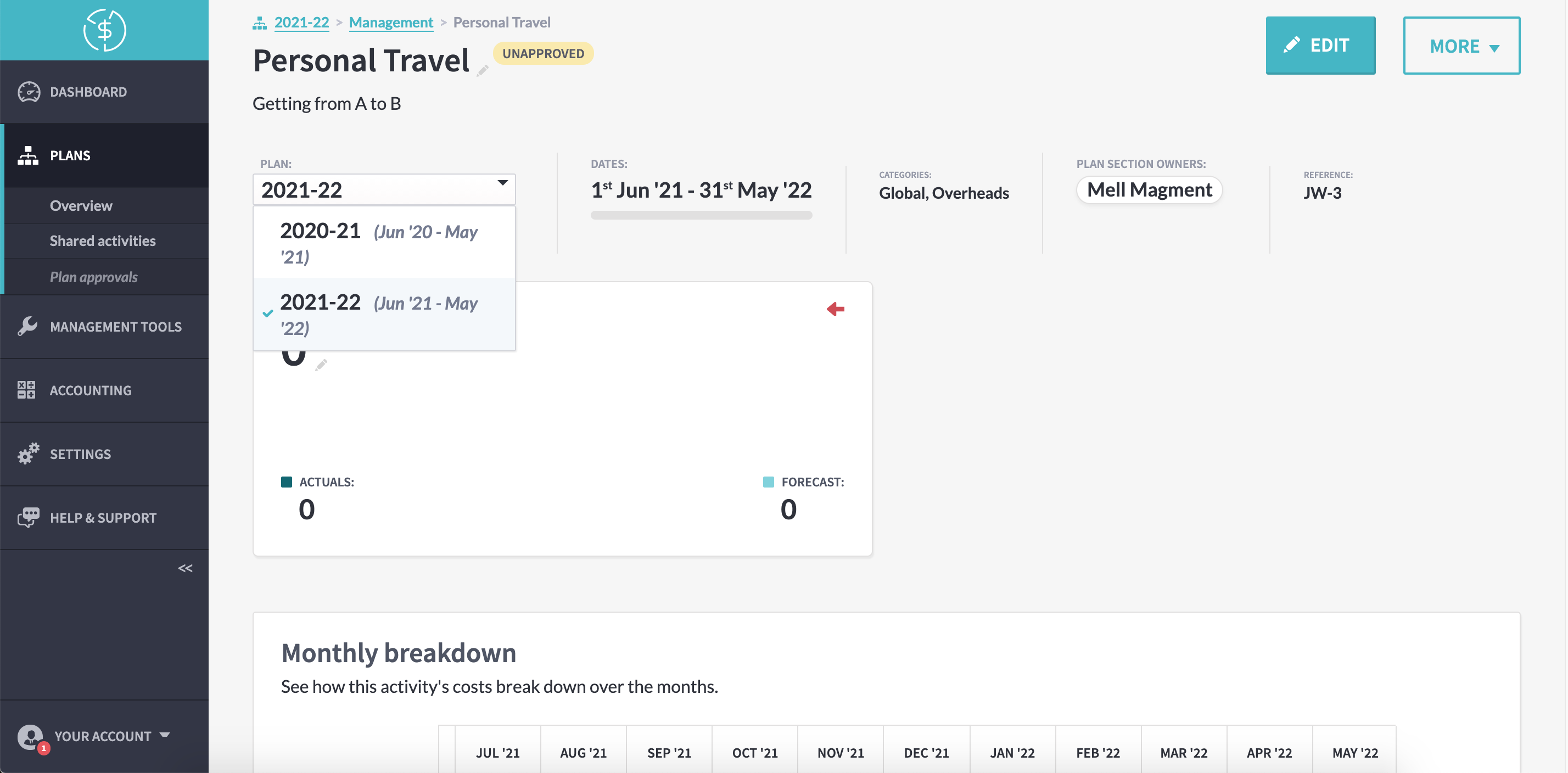
All that’s left is to go through the new plan, adding the new budgets and making whatever changes you need to. You can delete plan sections and activities without affecting the original plan – while being able to quickly compare long, ongoing projects between them.
(Though keep your eyes peeled – we’ll be adding incremental budgeting options soon, so you can carry across the numbers you care about and make your new budget even faster!  )
)
The post Feature spotlight: copying a plan appeared first on Beyond.
]]>The post Feature spotlight: breakdown reports appeared first on Beyond.
]]>Get a high-level overview of a plan (or multiple plans) broken down by the details that are most important to you – profit and loss, company structure, or custom categories.
Then delve into the details where you need to, drilling down into departments, teams, and individual contributions to the plan to get a full picture of your budget – and any potential problems.
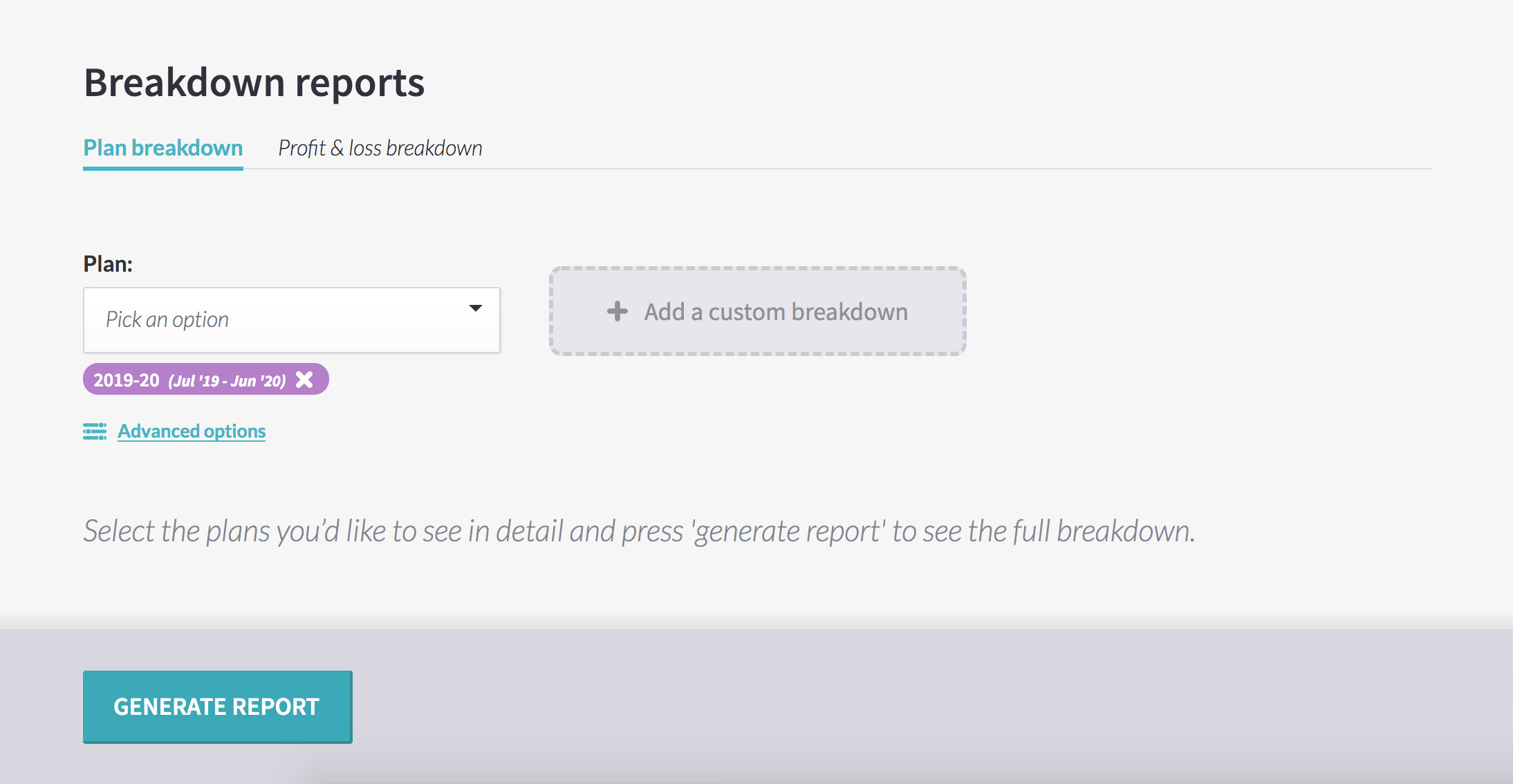
Plan breakdown reports
Available to managers and power users, the breakdown reports page is inside ‘management tools’.
To save you time, the plan your organisation is currently working on – like the 2020 budget – is pre-selected. Hit ‘generate report’ to see the plan, broken down by its first level of subsections.
Click the arrow by any subsection to drill down deeper, seeing that subsection’s subsections or its activities. Or, click the icon beside the section or activity name to jump directly to that part of the plan, to edit or manage it as needed.
When you’re finished, click the back button on your browser or ‘management tools’ in the navigation to return to the report.
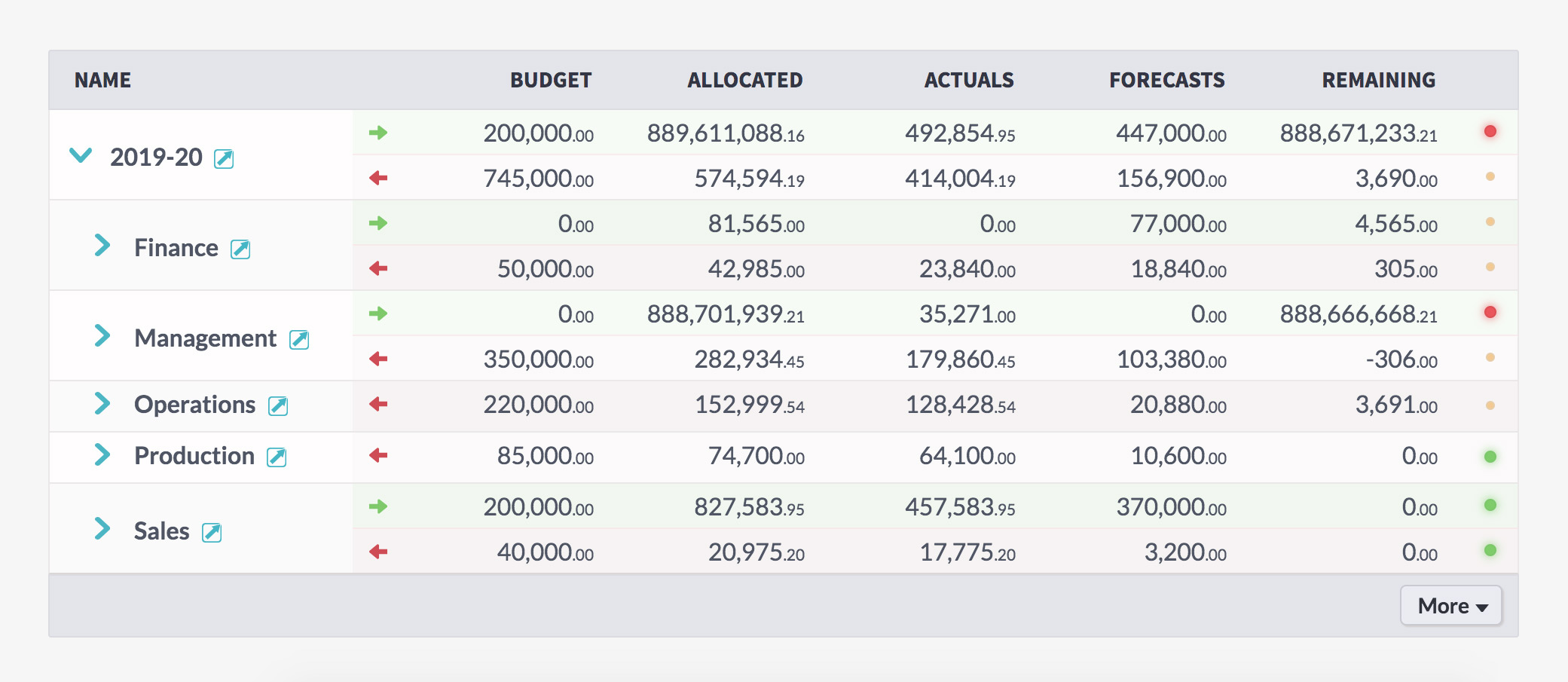
You can see the high-level details on the report itself – budget, allocated, actuals, forecasts, and remaining amount.
You can also see a status indicator for each section of the plan, showing if it’s over or under budget, so you can see which sections need attention.
View the report however it most makes sense to you
The report has toggles for ‘display’, ‘type’, and ‘view’ which you can change to see what’s most relevant for you.
Switch between a number-heavy table layout, to see the nitty-gritty details, or a graph if you prefer to see things more visually.

Focus on just the income or expense, under ‘type’, or click ‘both’ to see a full view of your business.
And click ‘month-by-month’ to see the figures broken into their allocated, actual, and variance figures for each month across the life of the plan, rather than the zoomed-out ‘overview’ of the budget.
And, of course, you can export your data to a .CSV file if you need to take it out of Beyond by clicking the ‘more’ button at the bottom of the report.
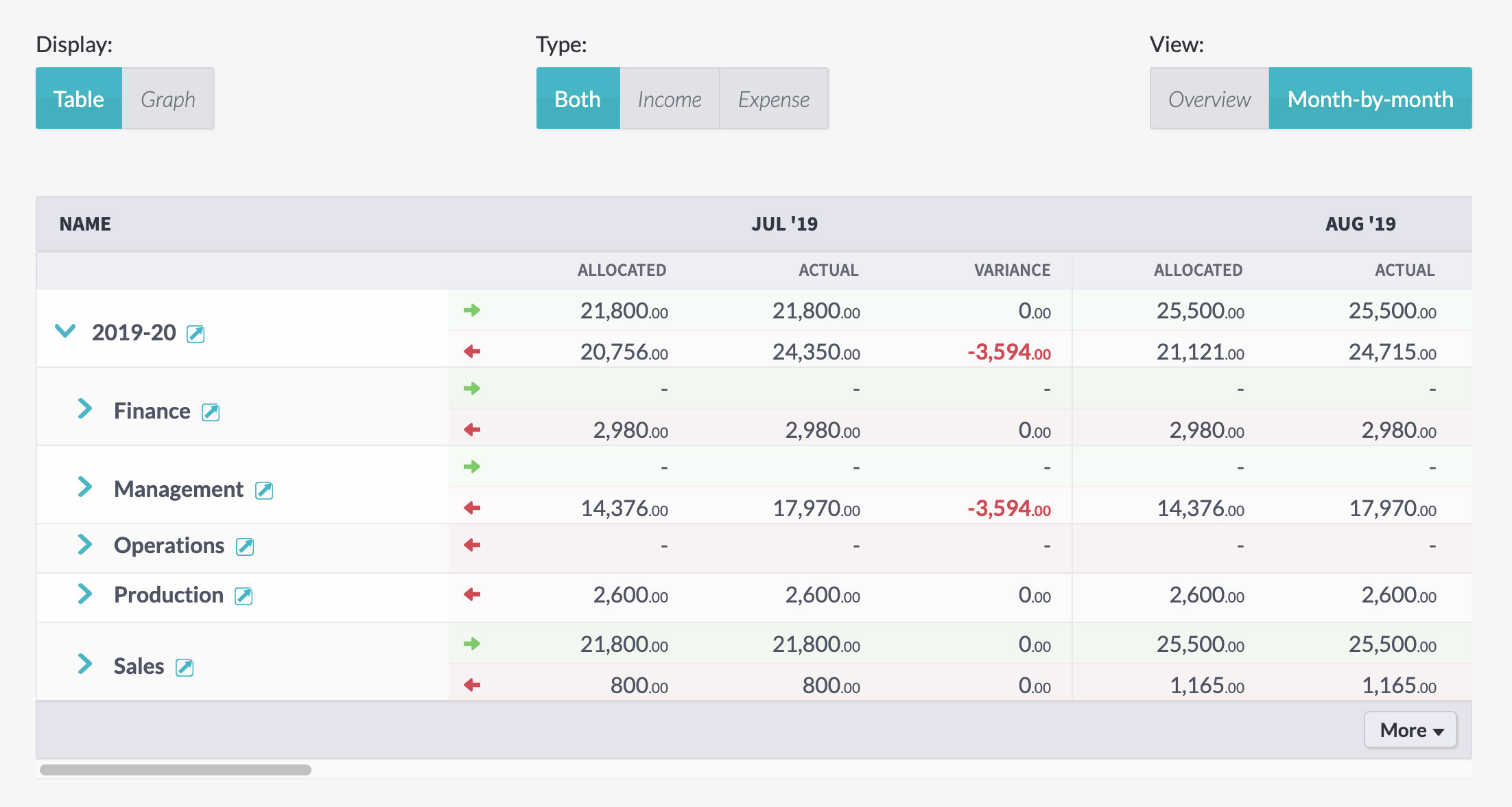
Profit and loss reports
And you can see more than the allocated and actual figures in your report – you can see a full profit and loss breakdown of your plan by clicking the ‘profit & loss breakdown’ tab at the top of the page.
At the top of the screen, you’ll see options for ‘company’ and ‘plan section’, allowing you to look across everything or to delve into particular details.
Hit ‘generate report’ to see how the figures breakdown into turnover, profit, and costs.
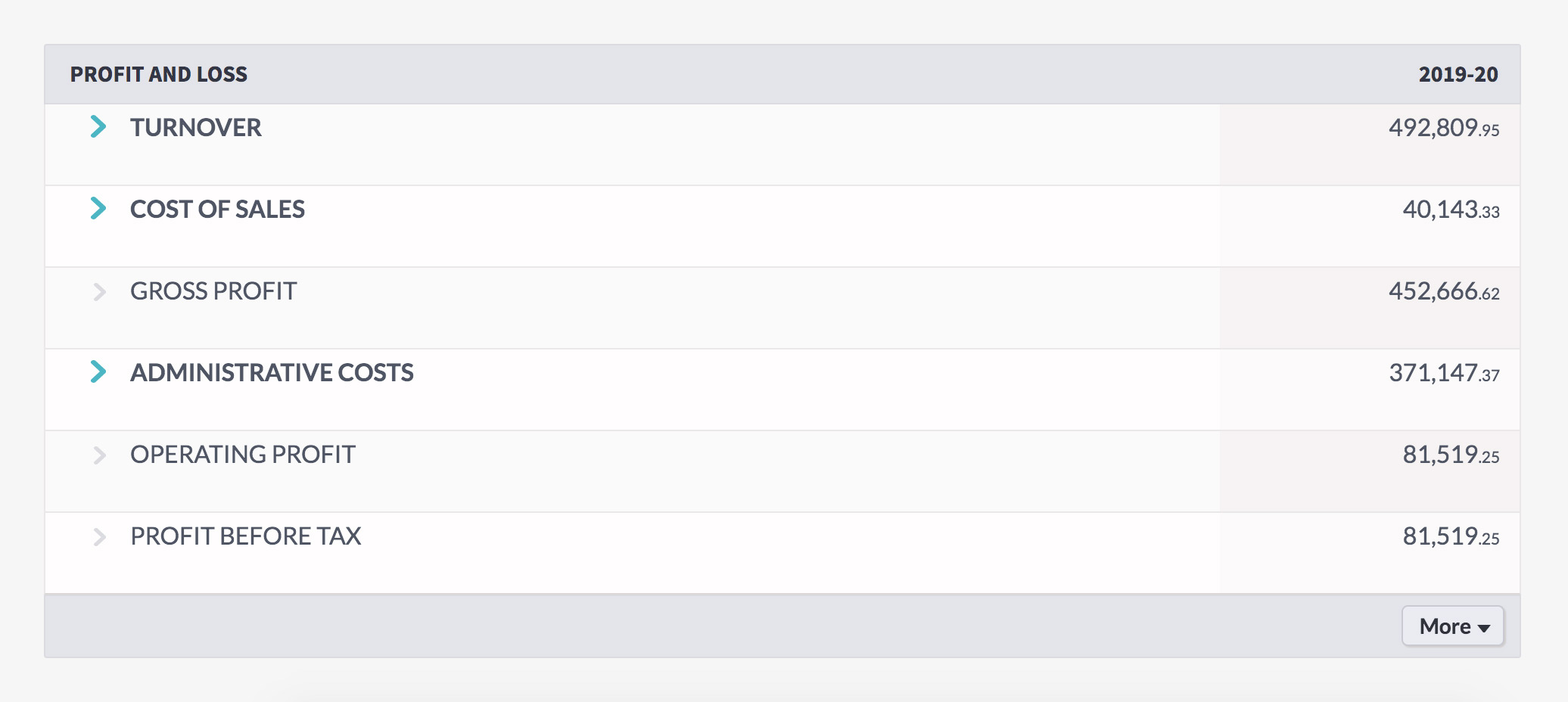
Viewing multiple plans in a single report
You can choose as many current, upcoming, and past plans as you’d like to see from the ‘plan’ dropdown.
Click the cross by a plan’s name to remove it from the report.
By default, the report will be broken down by the top level of each plan, showing each plan in separate sections.
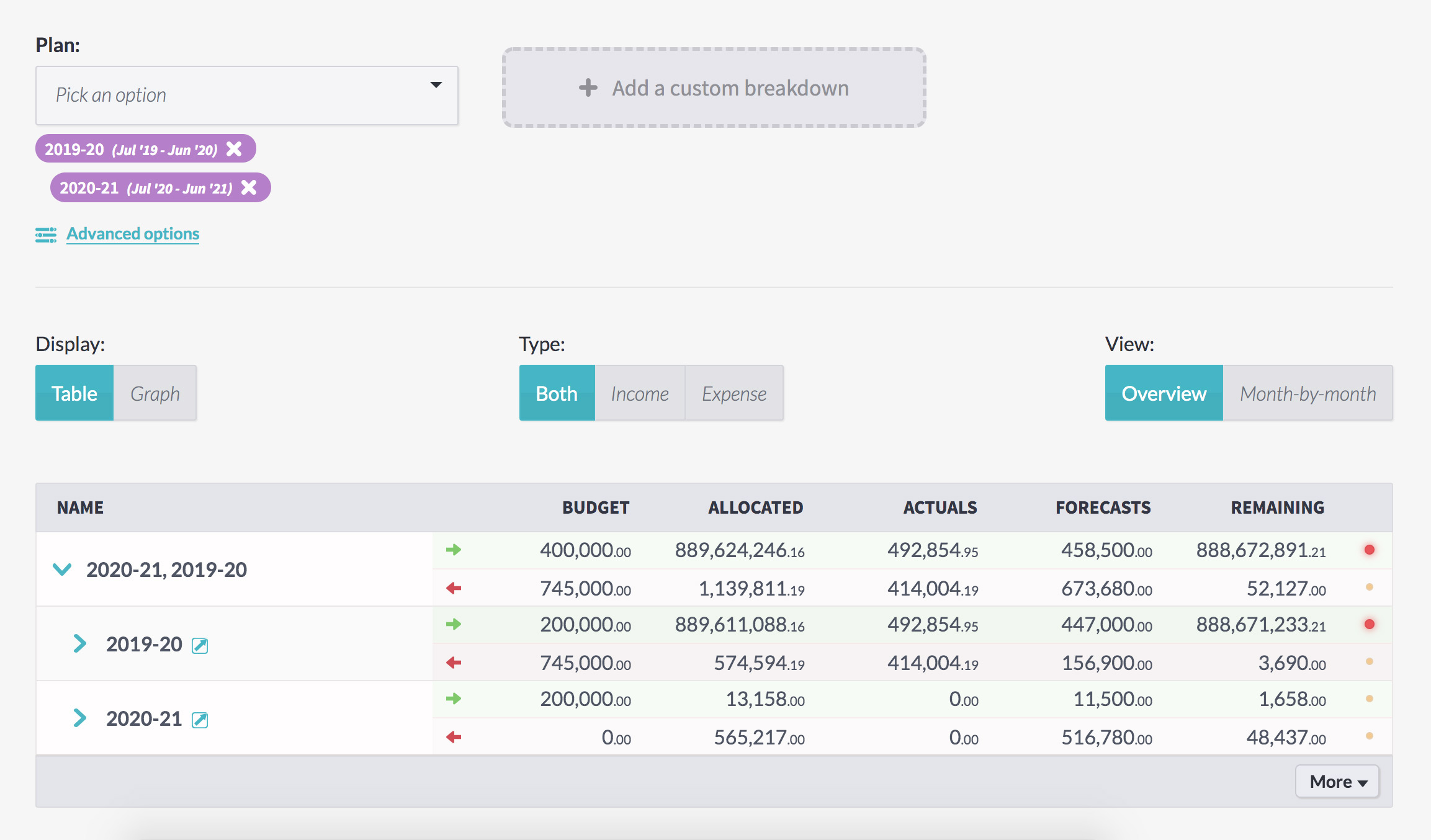
You can compare plans more closely by choosing a custom breakdown.
Custom report breakdowns
You can split the report by different sections and values by choosing a custom breakdown.
Click the ‘add a custom breakdown’ box next to the plan dropdown field to see the breakdown options. You can choose a different plan section level or an activity category.
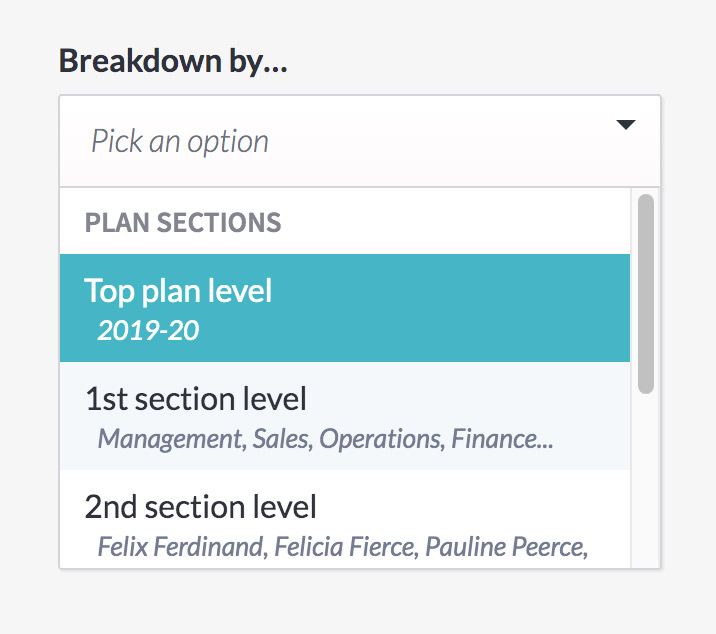
Breaking reports down by plan section level
Plan section levels are all the plan subsections at that level of their plan.
For example, here, the 2019-2020 plan is broken into five subsections. These are at the first level.

Each of those subsections either have their own subsections – the second level – or have activities.
If you wanted to see a report on two different plans, starting from their second level, the report would begin with the subsections of the subsections directly inside the parent plan.
You’d still be able to see this detail starting from higher up, though you’d need to drill into each subsection.
Looking across multiple plans, any plan subsections which share a name on the same level will be merged together, so you can track plans across different financial years or merge plans budgeted in different currencies.
Breaking reports down by activity category
Activity categories are a way to structure and organise activities across your company in whichever way makes the most sense to you.
For example, a multinational business might want a ‘location’ category, with options for ‘Asia’, ‘North America’, and ‘Europe’. Users would be asked to choose which location their activity belongs to when they make one.
With activities structured and organised this way, we can easily breakdown reports by location. (Or by initiative, department, function, client, favourite colour…)
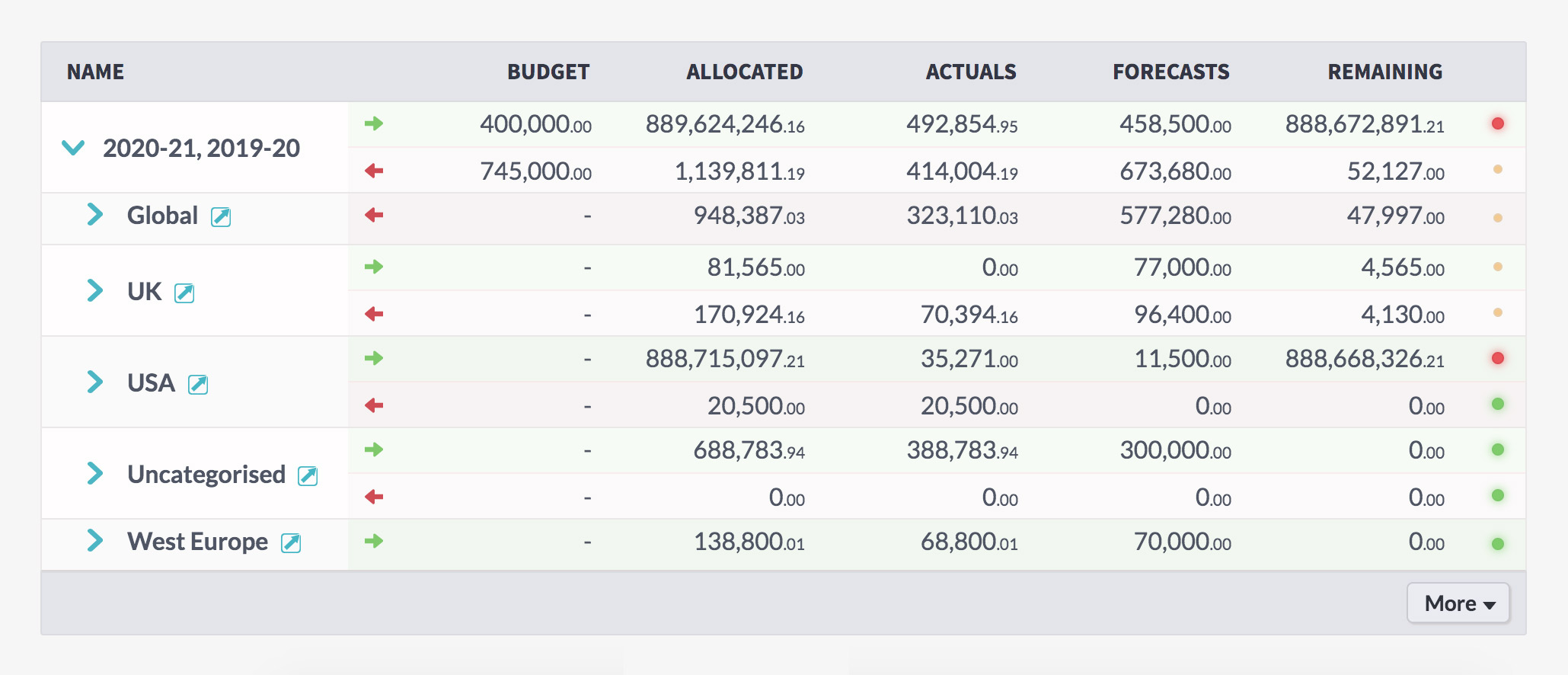
Once your activity categories have been set up by power users on the ‘settings’ page, you’ll see an ‘activity categories’ section at the bottom of the breakdown dropdown field.
Select a category to see the report broken down by that category’s options.

Creating a detailed breakdown
You can go as in-depth as you’d like to, selecting multiple section levels and multiple activity categories by pressing the ‘add another breakdown’ button.
And you can tweak and re-run the report as you need, to get a full picture of what’s happening. Breakdown the financial year by department first and location second – then run a new report, breaking down by location first, department second, to get a full, 360 picture of exactly what’s happening across your organisation.
Compare plans in different currencies
But seeing multiple plans on the same report goes deeper than keeping everything on one screen – if you have plans in different currencies, for a multinational business, you can convert them into the same currency to easily compare how different parts of the business are running.
Click ‘advanced options’ at the bottom of the report form to see a currency conversion rate for every plan you’ve chosen. You can manually set this to whatever you need, for complete control over how the numbers in the plan will be presented.
Setting the rate to ‘1’ won’t change anything. ‘2’ will double the amount. ‘0.75’ will reduce the figures by 25%.
This is also handy for running reports for your plans in a different currency. If you need to show American investors how their dollars are working, changing the rate to the conversion amount, like 1.24, will convert a GBP plan into USD.
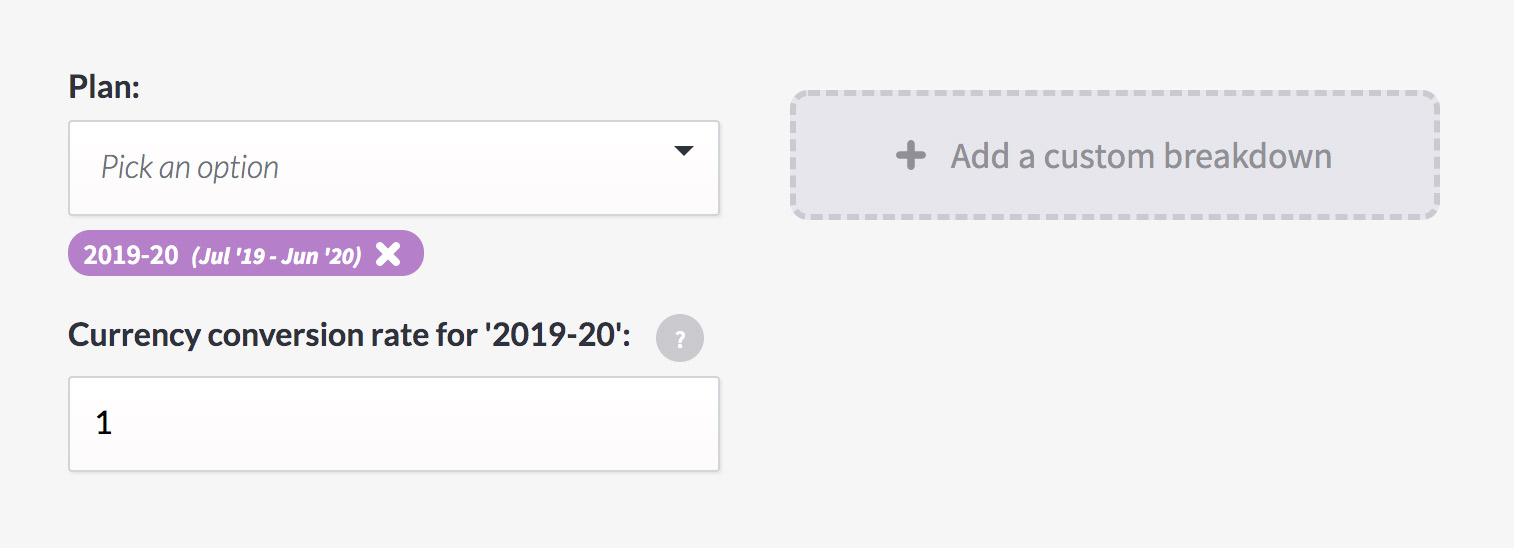
See what’s really happening in your business
Run a breakdown report now to see what’s really happening in your business.
And, if you have any ideas or suggestions for other management tools you’d like to see, let us know! We’re here to make budgeting easier for you. (Yes, you specifically.)
The post Feature spotlight: breakdown reports appeared first on Beyond.
]]>The post Rethinking the finance function in the age of robots appeared first on Beyond.
]]>Coming for our data, coming for our jobs, and (if the more dramatic reports are to be believed) coming for our very existence.

Or are they?
Let’s pick apart the A.I. fact from the hype and see where the real opportunities lie for the future finance function.
They are already here
A.I. is already transforming core functions of a typical accountant. Repeated processes based on structured data are ripe for automation. Things like:
- Invoice chasing
- Matching and reconciling transactions
- Invoice coding
- Anomaly and fraud detection
After all, A.I. is measurably faster and more accurate than us fleshy meat-bags at these repetitive tasks. And besides, this work is pretty boring anyway…
They are getting smarter
Nerves start to jangle when we see the next wave of intelligence starting to be deployed. Recent advancements in natural language processing and machine learning helps A.I. deal with both the nuances of text and the ever-present ambiguity of a business’s finances. This brings a far greater swathe of traditional accountancy work into reach. We are starting to see:
- Fully automated bookkeeping
- Advanced report creation and statutory filings
- Analysis of legal and tax documents
- Deep predictive analytics
- Smart audit assistants
Certainly starting to encroach on some classic value-add activities of a typical finance function.
[You don't need to see another generic yet ominous picture of a robot using a keyboard]
(what kind of self-respecting robot needs to use a keyboard anyway...??)
Expectations are changing
People’s beliefs of what technology can do for us is fundamentally changing. Across almost all industries, there is a growing expectation that automation will be bundled along with core services. As we shop online, we expect to see helpful recommendations; as we get into a car we expect it to direct us to our destination (and soon to take us there altogether); as we bank we expect to get smart alerts and reminders.
Accounting is no different. There will, of course, be adjustments needed as traditional tasks are commoditised and old revenue streams dry up, but this also raises huge opportunities. This is not a zero-sum game.
A prosperous co-existence
In a business context, A.I. is nothing without people.
While A.I. unlocks accounting superpowers, finance professionals are needed to put them to good use. Tool selection and setup, ongoing interpretation and tuning, and – of course – accountability are all roles which will need a human touch for the foreseeable future. After all, with great power comes great responsibility.
More importantly, as accountants’ time is freed up from menial tasks, they can shift their focus to a higher level, the strategic objectives of the company. Advisory services will become a fertile and lucrative hunting ground. Goodbye business policeman, hello business partner.

Power to the people
Vendors will often say you just need a smart new machine learning tool or shiny dashboard to gain a magical insight into a business. However, as any good A.I. engineer will tell you, an algorithm is only as good as the data it has access to.
This means, when trying to truly understand the workings of a business, you have to engage the real driving force – its people. Their knowledge, understanding of risks and plans for the future are always essential for true insights.
Here, A.I. can be an enabler – removing bottlenecks and giving people superpowers.
And ultimately it is a tool of empowerment – helping information flow more freely and enlightening decision-making.
Not so scary after all.
Bringing this to life
In order to build this deep partnership, it’s essential that your systems:
- Truly understand the business at its most granular level – its people and the context of all activities across the organisation.
- Always contain the most up-to-date data, link with all your tools, and can quickly flag issues, anomalies and opportunities as – or before! – they arise.
- Enable the company to quickly act on the decisions that can be made from this data.
We’ve created Beyond around these exact demands, deploying A.I. in a way that puts people – not robots – at the centre.
This post originally appeared as an article on AccountingWeb
The post Rethinking the finance function in the age of robots appeared first on Beyond.
]]>